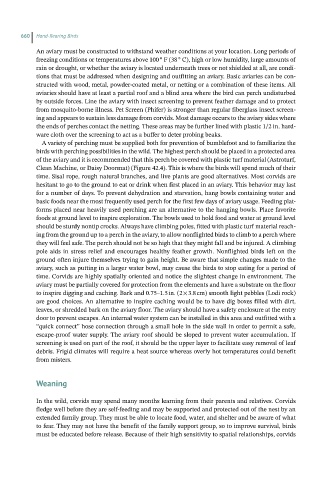Page 659 - Hand rearing birds second
P. 659
660 Hand-Rearing Birds
An aviary must be constructed to withstand weather conditions at your location. Long periods of
freezing conditions or temperatures above 100 ° F (38 ° C), high or low humidity, large amounts of
rain or drought, or whether the aviary is located underneath trees or not shielded at all, are condi-
tions that must be addressed when designing and outfitting an aviary. Basic aviaries can be con-
structed with wood, metal, powder-coated metal, or netting or a combination of these items. All
aviaries should have at least a partial roof and a blind area where the bird can perch undisturbed
by outside forces. Line the aviary with insect screening to prevent feather damage and to protect
from mosquito-borne illness. Pet Screen (Phifer) is stronger than regular fiberglass insect screen-
ing and appears to sustain less damage from corvids. Most damage occurs to the aviary sides where
the ends of perches contact the netting. These areas may be further lined with plastic 1/2 in. hard-
ware cloth over the screening to act as a buffer to deter probing beaks.
A variety of perching must be supplied both for prevention of bumblefoot and to familiarize the
birds with perching possibilities in the wild. The highest perch should be placed in a protected area
of the aviary and it is recommended that this perch be covered with plastic turf material (Astroturf,
Clean Machine, or Daisy Doormat) (Figure 42.4). This is where the birds will spend much of their
time. Sisal rope, rough natural branches, and live plants are good alternatives. Most corvids are
hesitant to go to the ground to eat or drink when first placed in an aviary. This behavior may last
for a number of days. To prevent dehydration and starvation, hang bowls containing water and
basic foods near the most frequently used perch for the first few days of aviary usage. Feeding plat-
forms placed near heavily used perching are an alternative to the hanging bowls. Place favorite
foods at ground level to inspire exploration. The bowls used to hold food and water at ground level
should be sturdy nontip crocks. Always have climbing poles, fitted with plastic turf material reach-
ing from the ground up to a perch in the aviary, to allow nonflighted birds to climb to a perch where
they will feel safe. The perch should not be so high that they might fall and be injured. A climbing
pole aids in stress relief and encourages healthy feather growth. Nonflighted birds left on the
ground often injure themselves trying to gain height. Be aware that simple changes made to the
aviary, such as putting in a larger water bowl, may cause the birds to stop eating for a period of
time. Corvids are highly spatially oriented and notice the slightest change in environment. The
aviary must be partially covered for protection from the elements and have a substrate on the floor
to inspire digging and caching. Bark and 0.75–1.5 in. (2 × 3.8 cm) smooth light pebbles (Lodi rock)
are good choices. An alternative to inspire caching would be to have dig boxes filled with dirt,
leaves, or shredded bark on the aviary floor. The aviary should have a safety enclosure at the entry
door to prevent escapes. An internal water system can be installed in this area and outfitted with a
“quick connect” hose connection through a small hole in the side wall in order to permit a safe,
escape-proof water supply. The aviary roof should be sloped to prevent water accumulation. If
screening is used on part of the roof, it should be the upper layer to facilitate easy removal of leaf
debris. Frigid climates will require a heat source whereas overly hot temperatures could benefit
from misters.
Weaning
In the wild, corvids may spend many months learning from their parents and relatives. Corvids
fledge well before they are self-feeding and may be supported and protected out of the nest by an
extended family group. They must be able to locate food, water, and shelter and be aware of what
to fear. They may not have the benefit of the family support group, so to improve survival, birds
must be educated before release. Because of their high sensitivity to spatial relationships, corvids

